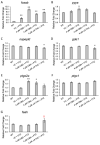Phytocannabinoids Reduce Seizures in Larval Zebrafish and Affect Endocannabinoid Gene Expression
- PMID: 37759798
- PMCID: PMC10526363
- DOI: 10.3390/biom13091398
Phytocannabinoids Reduce Seizures in Larval Zebrafish and Affect Endocannabinoid Gene Expression
Abstract
Cannabis has demonstrated anticonvulsant properties, and about thirty percent of epileptic patients do not have satisfactory seizure management with standard treatment and could potentially benefit from cannabis-based intervention. Here, we report the use of cannabinoids to treat pentylenetetrazol (PTZ)-induced convulsions in a zebrafish model, their effect on gene expression, and a simple assay for assessing their uptake in zebrafish tissues. Using an optimized behavioral assay, we show that cannabidiol (CBD) and cannabichromene (CBC) and cannabinol (CBN) are effective at reducing seizures at low doses, with little evidence of sedation, and our novel HPLC assay indicates that CBC is effective with the lowest accumulation in larval tissues. All cannabinoids tested were effective at higher concentrations. Pharmacological manipulation of potential receptors demonstrates that Gpr55 partially mediates the anticonvulsant effects of CBD. Treatment of zebrafish larvae with endocannabinoids, such as 2-arachidonoylglycerol (2-AG) and anandamide (AEA), altered larvae movement, and the expression of genes that regulate their metabolism was affected by phytocannabinoid treatment, highlighting the possibility that changes to endocannabinoid levels may represent one facet of the anticonvulsant effect of phytocannabinoids.
Keywords: GPR55; cannabis; endocannabinoid; epilepsy; phytocannabinoid; seizure; zebrafish.
Conflict of interest statement
The authors declare no conflict of interest.
Figures





References
-
- Scheffer I.E., Berkovic S., Capovilla G., Connolly M.B., French J., Guilhoto L., Hirsch E., Jain S., Mathern G.W., Moshé S.L., et al. ILAE classification of the epilepsies: Position paper of the ILAE Commission for Classification and Terminology. Epilepsia. 2017;58:512–521. doi: 10.1111/epi.13709. - DOI - PMC - PubMed
Publication types
MeSH terms
Substances
LinkOut - more resources
Full Text Sources

